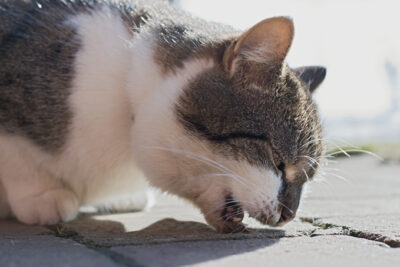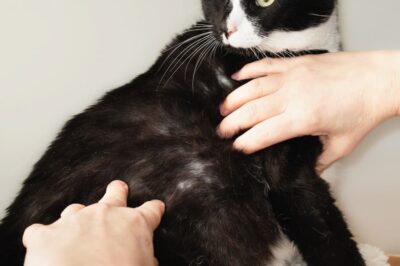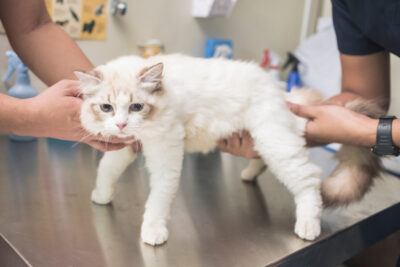Scabs on Cats: Types and Common Causes

If you’ve ever scraped your knee, you likely noticed scab (crust) form over it. Scabs on cats are basically dried blood that has clotted over the area to protect it and stop the bleeding. So, scabs are a good thing!
If your cat gets a scab, you’re probably wondering why or how it happened. Read on to learn more about different types of scabs on cats, common causes, and what to do about them.
Types of Scabs on Cats
Scabs tend to be a little firm and are usually dry or scaly. They range in size from less than 1/8 of an inch up to a couple inches in length, depending on what is being covered. Scabs on cats can be a variety of colors, which can provide a hint about how the wound is doing. Different cat scab colors may include:
- Red scabs. These scabs form to stop bleeding from the wound.
- Yellow scabs. These scabs contain a thin and transparent fluid that helps with healing (serous fluid). These are much different than scabs on infected wounds.
- Green scabs. These scabs form when an infection is present in the wound. They can appear green-yellow, and there is usually a thick goopy discharge underneath the crust.
- Brown scabs. These are scabs that stopped bleeding and have changed color from red over time.
In cats, there is a special kind of scab called a miliary crust. Miliary crusts are very small scabs that are brown in color and around 1 millimeter wide. Usually, these appear around the head or neck on allergic cats, particularly those with fleas. Most of the time, they are so small you can’t see them under your cat’s fur, but you can feel a bunch of little bumps.
Common Causes of Scabs on Cats

There are many causes of scabs on cats, including:
Allergies to fleas, food, or the environment. If a cat is allergic to something they are exposed to, their immune system will overreact. This exaggerated response causes inflammation and itchiness of the skin. Crusts from allergies can appear anywhere on the body and can look very different between cats. Flea allergy tends to cause miliary scabs on the neck.
Ear infections. Cats scratch their ears with their back claws. If they have an ear infection, it creates significant itchiness. Your cat will scratch until injuring themselves, resulting in abrasions and crusts behind the base of the ears.
Ringworm. A fungus causes inflammation in the skin, resulting in scaly crusts with no fur that are typically circular. Scabs from ringworm appear most often on the face, ears, paws, and tail.
Mite infestations. Mites either chew on or burrow into the skin, causing massive inflammation. Location of crusts can vary depending on the type of mite, but the most common locations are on the face, ears, paws, and lower limbs.
Immune diseases such as eosinophilic dermatitis and pemphigus foliaceus. A specific inflammatory cell called eosinophils causes eosinophilic dermatitis, and the crusts can appear anywhere on the body. Pemphigus foliaceus frequently affects the part of the ear that sticks out (the pinnae) but it creates scabs on the rest of the body, too.
Cancer such as squamous cell carcinoma. Cancer invades the skin, causing significant inflammation. Squamous cell carcinoma tends to occur where fur is thin, such as the pinnae or the bridge of the nose.
Adverse drug reactions. Research has not found the actual reason adverse drug reactions occur, and they can occur to any medication. These drug reactions create significant itchiness and inflammation, resulting in crusts anywhere on the body.
Common Areas Where Cat Scabs Appear

There are many possibilities for why crusts or scabs appear on your cat’s body. The location of cat scabs can provide a hint about the cause. But keep in mind that your veterinarian cannot identify the cause of your cat’s scabs based on location alone. Bacterial infections can cause crusts to appear anywhere on a cat’s body. Allergies to fleas or other insects, food, the environment, or to medications can also cause crusts anywhere.
Some cat scab locations that may provide clues about their cause include:
- Ears: Ringworm, immune disease, squamous cell carcinoma
- Behind/around the ears: Ear infection
- Nose: Ringworm, allergy to insects like mosquitoes, squamous cell carcinoma
- Chin: Allergies
- Neck: Allergies, especially to fleas
- Back, sides, or belly: Allergies, ringworm, mite infestations
- Paws: Ringworm, immune disease
How to Treat Scabs on Cats
Many times, scabs will not go away on their own. Most conditions require veterinary treatment. At home, you could apply petroleum jelly to moisten a scab and protect the skin underneath, but many cats will lick it off — partially because most scabs are itchy. While petroleum jelly may help the crust fall off, it won’t treat any underlying causes.
If infection is present, your veterinarian will recommend topical ointments with anti-inflammatory medicine (typically steroids) and antibiotics. You should always seek veterinary advice before applying medicated ointment onto your cat.
Keep your cat treated with a flea preventative every month all year round, particularly if they have a history of allergies or scabs.
Some conditions are best treated with medicated shampoo. This means you would lather shampoo on, leave it on your cat for 10 minutes, then rinse off and pat dry. Medicated mousse is also an option, as most cats don’t like to be bathed.
If your cat has recurring scabs, food allergy could be to blame. Feed a diet that contains a single protein source that your cat has never had before — no treats, no other cat food — for at least 8 weeks to see if symptoms abate.
Your veterinarian is likely to prescribe medication to decrease inflammation and itchiness. Antibiotics are likely. They will look inside the ears with an otoscope — a special tool meant to view the ear canal. If the ears are inflamed, your cat needs treatment for ear infection.
Your veterinarian may run a test for ringworm to rule it out. If ringworm infection is present, they will prescribe antifungal medication.
Mites are often treated with specific flea preventives or topical treatments.
Immune disease is treated with immunosuppressive medications to stop the immune system from overreacting.
How to Prevent Scabs on Cats

You cannot always prevent scab in cats. However, you can prevent some of the common causes of cat scabs, such as fleas. Keep your cat on year-round flea control. Many cat flea preventatives also combat mites. If your cat goes outdoors, avoid times of day with the most sun exposure, particularly if your cat has thin fur or white fur. Prolonged sun exposure might be a contributing factor to squamous cell carcinoma.
Once your veterinarian has identified an underlying cause of cat scabs, there may be ways of preventing flare-ups. For example, if your cat has a food allergy, only feed the special diet recommended by your veterinarian and avoid other foods and treats.









